Today I got to see my first Weddell seals! Stacy and I met Susan Detweiler from the Field Safety Training Program and Carl Klimt, our volunteer for the day, and drove out on the sea ice in the Tucker for about 45 minutes to an area called the Cinder Cones. There are flagged roads on the sea ice that are known safe routes, but we needed to flag a new route for the Challenger Caterpillar to bring in the Reedrill and make two new dive holes.
Stacy and Susan started checking the sea ice cracks (where the seals find thin ice for breathing holes and to haul out on the ice) while Carl and I walked closer to two seals.
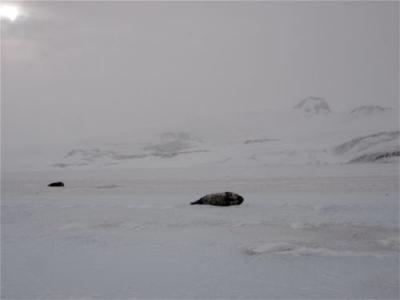
Weddell seals on the sea ice
"Weddell seals are wonderful animals to work with" says Weddell seal researcher, Dr. Randall Davis. "They're very mild mannered since they have no natural land predators. Unlike ring seals in the Arctic that have to deal with polar bears and (human) hunters, Weddell seals usually just ignore you. It's very rare that they would bite."
The researchers have permits to get close to the animals, but Carl and I were not allowed to have the seals react to our presence, so we didn't get too close. I was happy to have a good zoom lens on my camera!
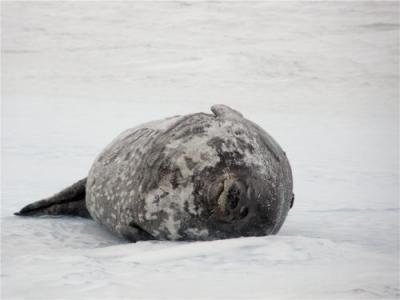
Weddell seal taking a snooze on the sea ice
The largest terrestrial organism in Antarctica is a mite so there are no land-based predators of these large mammals. Seals and penguins are considered marine vertebrates.
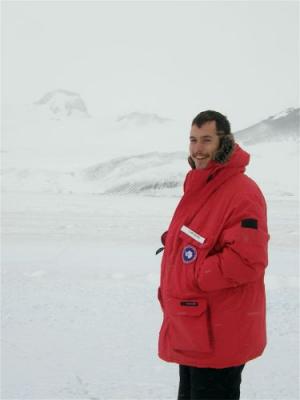
Carl enjoying the seals
For my FALA students and anyone else that loves art, Carl is an artist. He is also related to Gustav Klimt. I wonder what a Gustav Klimt painting of a Weddell seal would be like!
We walked back to Stacy and Susan and put our sea ice safety training to good use. We (okay, mostly Carl!) drilled holes across the cracks and measured the depth of the sea ice. Susan calculated that it was safe enough for the Challenger to cross so then we marked the path to the new dive hole sites.
Most of the time we used a power drill but sometimes, for the shorter flag holes, we struggled with the hand auger.
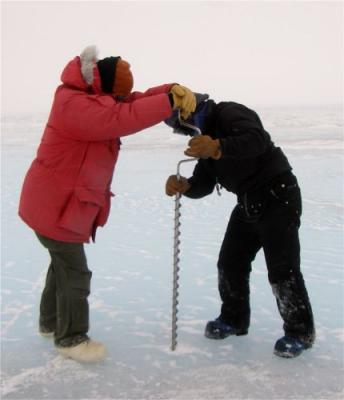
Stacy (left) and Susan using a hand auger
The weather got worse and our visibility became poor so we headed back to McMurdo. It turned out to be amazingly lucky that we turned around when we did, as the Tucker broke down right outside of McMurdo! We put our hazardous waste management training to work (maybe all those trainings will get used!) and we used a "spill kit" to contain the dripping coolant. Stacy and Susan handled the radio to get help while Carl and I shoveled the coolant-covered snow into plastic bags. Everyone here is very careful not to get any pollutants into the environment.
Later, Bryan and I ran an errand to the old aquarium. We both photographed this sign because it has such lovely vocabulary.
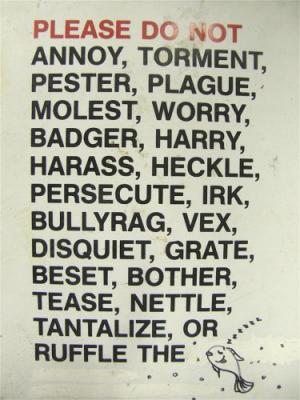
Don't bother the fish sign!
Since Bryan wasn't allowed to bother the fish, he only pestered the starfish in the tank he is trying to photograph.
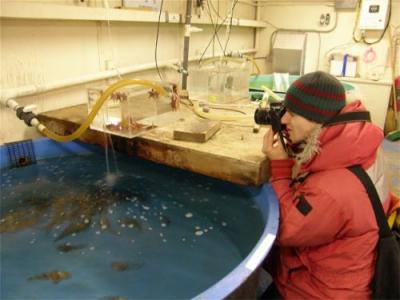
Bryan is harassing the starfish instead of the fish
Each Wednesday evening there is a science lecture. Tonight we learned about the microbes living at the base of the ice in Antarctica. They only discovered bacteria in the ice of the Vostok core (a Russian deep-ice core) in 1999 - less than ten years ago. The microbiologists here believe bacteria may be surviving in many extreme ice environments. This would have implications for bacteria possibly surviving in the Mars ice caps as well. "Exobiology" is the study of possible life on other planets, so some exobiologists come to Antarctica for their research.
There is science and art everywhere you look!

